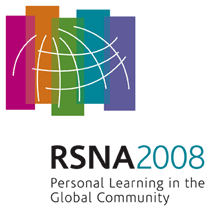
Abstract Archives of the RSNA, 2008
Andetta Rotilla Hunsaker MD, Presenter: Nothing to Disclose
Isabel Borges Oliva MD, Abstract Co-Author: Nothing to Disclose
Tianxi Cai PhD, Abstract Co-Author: Nothing to Disclose
Beatrice Trotman-Dickenson MBBS, Abstract Co-Author: Nothing to Disclose
Ritu Randhawa Gill MBBS, Abstract Co-Author: Nothing to Disclose
Frank John Rybicki MD, PhD, Abstract Co-Author: Speakers Bureau, Toshiba Corporation
Advisory Board, Toshiba Corporation
Speakers Bureau, Siemens AG
Speakers Bureau, Bracco Group
Advisory Board, Bracco Group
Advisory Board, Vital Images, Inc
To test the hypothesis that lowering volume of iodinated contrast for CT pulmonary angiography (CTPA) does not adversely decrease enhancement of both large and smaller pulmonary arteries.
Four hundred fifty-two (187 men; mean age 56.2 years) consecutive CTPA inpatients imaged (64 slice MDCT, 1.0–1.25 x 0.75–1.0 mm slice thickness, 100 kV, ~200 mAs) at a teaching hospital between 10/07 – 1/08 were retrospectively evaluated. All received intravenous contrast (370mg I / mL) at 3.5-4 mL/second without saline chase; bolus tracking was positioned over the main pulmonary artery. Patients were stratified into those who received 125mL contrast (n=229) or 75 mL (n=223).
Hounsfield units (HU) were measured at four levels in the left pulmonary artery: lobar, posterobasal segment, posterobasal and medial basal subsegmental rami. Additionally, three thoracic radiologists, blinded to contrast dose, independently evaluated the quality of enhancement using a 3 point scale at the same levels. Two-sample t-test was used to compare mean HU between 125cc vs 75cc patients. Concordance between HU measurements greater than 250 and image quality ratings was measured using the C-statistic. Intereader agreement was measured using Kendall’s coefficient of concordance.
Mean HU differences between 125cc vs 75cc patients at lobar, segmental, and two subsegmental levels were 11.00, 0.18, -13.66, and -19.97, respectively. Differences were not statistically significant (P > 0.21) at lobar, segmental and posterobasal subsegmental ramus, although the mean HU trends (P = 0.07) towards higher opacification of medialbasal subsegmental ramus among 75cc patients. Across all 4 pulmonary artery segments there is good concordance between subjective ratings of enhancement and objective measurements of arteries with HU ≥ 250. Concordance rates range from 0.66 to 0.74 and are significantly higher than the null value of 0.50 (p > .05). There was good intereader agreement with concordance coefficient = 0.70 (95% CI [0.66, 0.74]).
Both objective and subjective measures of contrast opacification including larger and smaller pulmonary arteries support a reduction in the volume of contrast medium required for CT pulmonary angiography.
Optimized CT pulmonary angiography should lower patient iodine exposure, reducing the overall cost of contrast media and potential nephrotoxicity.
Hunsaker, A,
Oliva, I,
Cai, T,
Trotman-Dickenson, B,
Gill, R,
Rybicki, F,
Reduced Volume of Iodinated Contrast Material in CT Pulmonary Angiography: Objective and Subjective Evaluation of Larger and Smaller Pulmonary Arteries. Radiological Society of North America 2008 Scientific Assembly and Annual Meeting, February 18 - February 20, 2008 ,Chicago IL.
http://archive.rsna.org/2008/6016847.html

